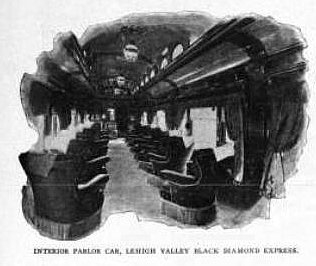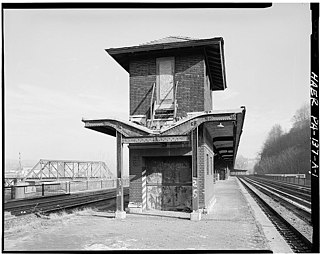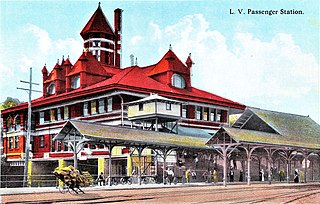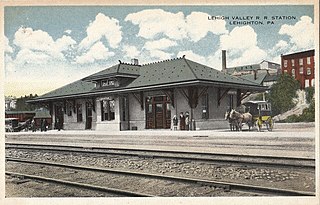The Lehigh Valley Railroad was a railroad in the Northeastern United States built predominantly to haul anthracite coal from the Coal Region in Northeastern Pennsylvania to major consumer markets in Philadelphia, New York City, and elsewhere.
The Lehigh and New England Railroad was a Class I railroad located in Northeastern United States that acted as a bridge line. It was the second notable U.S. railroad to file for abandonment in its entirety after the New York, Ontario and Western Railway. It was headquartered in Philadelphia.
The Belvidere-Delaware Railroad was a railroad running along the eastern shore of the Delaware River from Trenton, New Jersey north via Phillipsburg, New Jersey to the small village of Manunka Chunk, New Jersey. It became an important feeder line for the Lehigh Valley Railroad's join to the Central Railroad of New Jersey, which was constructed into Phillipsburg, NJ at about the same time. This connected Philadelphia and Trenton, NJ at one end of the shortline railroad to the rapidly growing lower Wyoming Valley region, and via the Morris Canal or the CNJ, a slow or fast connection to New York City ferries crossing New York Harbor from Jersey City, NJ. In 1871 the CNJ leased various railroads in Pennsylvania, most from the Lehigh Coal & Navigation Company allowing the CNJ to penetrate to the upper Wyoming Valley, over some stretches, competing directly with the Lehigh Valley Railroad and with the Lehigh Canal and the trunk road connection of the Belvidere Delaware Railroad to New York became less profitable since Philadelphia connected more easily to Northeastern Pennsylvania thereafter without needing a double-crossing of the Delaware River; a general revenue decline ensued, leading to the Pennsylvania Railroad acquiring the rights, where it served as part of the Pennsylvania Railroad (PRR) system, carrying mainly anthracite coal and iron ore from northeastern Pennsylvania to population centers along the coast.

The Black Diamond, also known as the Black Diamond Express, was the flagship passenger train of the Lehigh Valley Railroad (LV). It ran from New York to Buffalo from 1896 until May 11, 1959, when the Lehigh Valley's passenger service was reduced to four mainline trains.

The Susquehanna and New York Railroad was a short-line railroad connecting the Lehigh Valley Railroad at Towanda, Pennsylvania, with the Pennsylvania Railroad at Marsh Hill Junction. The railroad carried freight and passengers between Williamsport and Towanda by rail rather than using the Susquehanna River or the Pennsylvania Canal.

Robert Heysham Sayre was vice president and chief engineer of the Lehigh Valley Railroad. He was also vice president and general manager of Bethlehem Iron Company, the corporate precursor to Bethlehem Steel. The borough of Sayre, Pennsylvania and the small city of Sayre, Oklahoma were named in his honor.

The Lehigh Line is a railroad line in Central New Jersey, Northeastern Pennsylvania, and the Lehigh Valley region of eastern Pennsylvania. It is owned and operated by the Norfolk Southern Railway. The line runs west from the vicinity of the Port of New York and New Jersey in Manville, New Jersey via Conrail's Lehigh Line to the southern end of Wyoming Valley's Coal Region in Lehigh Township, Pennsylvania.
The Beaver Meadow Railroad & Coal Company (BMRC) was chartered April 7, 1830, to build a railroad from the mines near Beaver Meadows, Pennsylvania, beyond Broad Mountain along Beaver Creek to Penn Haven and along the Lehigh River through present-day Jim Thorpe, Pennsylvania to the Lehigh Canal at Parryville, Pennsylvania. The settlement of Beaver Meadows dated to a 1787 land sale to Patrick and Mary Keene, thence to Nathan Beach.

Easton is a defunct train station in Easton, Pennsylvania. It was originally built by the Lehigh Valley Railroad. As of 2017, the structure still exists and was blighted for at least 20 years, since its closing in the 1970s. The city of Easton obtained permission from Norfolk Southern Railway to clean up the property. The location only recently became a focal point for the city with the opening of Interstate 78 in the 1990s.

Allentown was a train station in Allentown, Pennsylvania. It was opened by the Lehigh Valley Railroad in 1890 and closed in 1961. The building was demolished in 1972. The station was located one block west of the Central Railroad of New Jersey's Allentown station.

The Lehigh Valley Terminal was a railroad station in downtown Buffalo, New York. The Lehigh Valley Railroad opened it in 1916, replacing an older station one block east at Scott and Washington streets. Lehigh Valley trains served at the station included the Black Diamond,Maple Leaf, and Star. The station handled the Lehigh Valley's passenger traffic in Buffalo until 1955, when it was demolished to make room for the Niagara Thruway (Interstate 190). The Lehigh Valley moved its operations to a smaller station outside the downtown area at Dingens and South Ogden Streets, which served until the end of all Lehigh Valley passenger service in 1961. The terminal also hosted the Erie Railroad's passenger trains from 1935 until 1951, when that railroad ceased serving Buffalo.

Laurys station, also known as Laury's station, was a Lehigh Valley Railroad station in Laurys Station, Pennsylvania. Both the station and locality drew their name from David Laury, a local notable who established a hotel on the site in 1832 and later served as postmaster.

Catasauqua station was a Lehigh Valley Railroad station in Catasauqua, Pennsylvania. It was located on the Lehigh Valley main line.

Lehighton station was a Lehigh Valley Railroad station that was located in Lehighton, Pennsylvania, USA. It was part of the Lehigh Valley main line, and was also the eastern terminus for Hazleton Branch passenger trains, although the branch diverged at Penn Haven Junction, north of Jim Thorpe.

The Jim Thorpe station, also known as the Mauch Chunk station or East Mauch Chunk station, was a Lehigh Valley Railroad station that was located in Jim Thorpe, Pennsylvania.

Flemington Junction station is a defunct Lehigh Valley Railroad station in Flemington Junction, New Jersey. It was located at the junction of the Lehigh Valley's Flemington Branch and Main Line, although the name predated the opening of the branch by eight years.

The Flemington Branch was a railroad line in Hunterdon County, New Jersey. It was owned and operated by the Lehigh Valley Railroad. It connected the borough of Flemington, New Jersey, with the Lehigh Valley's main line. It was opened in 1884 and abandoned in 1982.
The Elmira, Cortland and Northern Railroad was a railroad in the state of New York, in the United States. Its main line ran from Elmira, New York, to Camden, New York. It was formed in 1884 from the consolidation of other railroads and merged into the Lehigh Valley Railroad in 1905. Under the Lehigh Valley, it was known as the Elmira and Cortland Branch. Almost all of its former line has since been abandoned.
The Southern Central Railroad is a defunct railroad which operated in the state of New York in the nineteenth century. The company's line ran from Fair Haven, New York, on the south shore of Lake Ontario, to Athens, Pennsylvania, in the Southern Tier and just over the border into Pennsylvania. The company was incorporated in 1865 and became part of the Lehigh Valley Railroad system in 1895. Most of its line was abandoned by the Lehigh Valley Railroad between 1937–1979; the portion between Harford Mills, New York, and Owego, New York, is owned by the Tioga County Industrial Development Agency and operated by the Owego and Harford Railway.












